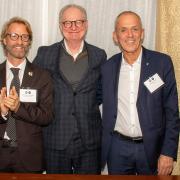Every few years, scientists take a step back to take a broader look at their field and determine what questions are most pressing—and what tools they will need to answer those questions.
This year the National Academies of Science, Engineering and Medicine are launching a study to set a vision for the next decades of elementary particle physics in a broad context. A committee of 17 physicists from around the world will participate in this study.
“We’ve been given free rein to think big—which is good, because the questions in this field are really big,” said Michael Turner, the Rauner Distinguished Service Professor Emeritus of Physics at UChicago, who co-chairs the committee along with Caltech physicist Maria Spiropulu.
“The agenda of the field is to understand the fundamental nature of matter, energy, space and time,” he said. “What is our place in the universe? Do we live in a multiverse? What came before the Big Bang? The opportunities in physics right now are absolutely extraordinary.”
The resulting study, expected to be released in 2024, is intended to help guide federal agencies, policymakers and academics as they make decisions about research, funding, and planning. Turner is one of three UChicago-affiliated scientists on the committee, along with fellow physicists Young Kee-Kim and Marcela Carena.
The ‘most exciting questions’
Over the past century, scientists have slowly built a comprehensive framework for our understanding of the universe—how it behaves and how it evolved. But a few puzzle pieces still don’t yet fit.
For example, from watching the movements of galaxies, scientists think there is some kind of substance affecting their orbits, known as “dark matter.” However, the mysterious substance is invisible to telescopes—no one has ever directly seen it. Other puzzles include explaining why more matter exists in the universe than antimatter; measuring the mass of neutrinos; and understanding how Einstein’s theory of general relativity fits in with quantum mechanics.
The new National Academies committee’s mission is to consider these and other outstanding questions and how they could be addressed.
Known as “Elementary Particle Physics: Progress and Promise,” or EPP-2024, the study is being undertaken at the request of the National Science Foundation and the U.S. Department of Energy. It will also take into account recommendations from two other large reports on the state of the field expected in the next two years: “Snowmass,” a group of thousands of members of the international particle physics community; and the Particle Physics Project Prioritization Panel or P5, which makes recommendations to U.S. agencies for the next 10 years of funding.
“To address many profound questions in the field of particle physics, we would need a good balance of facility sizes, from small- to large-scale projects. A large, complex project would take multiple decades from inception to completion,” said Kim. “Thinking long-term is, thus, critical.”
These projects are so large that no one nation can undertake them alone. More than 20 countries were involved in the Large Hadron Collider’s construction.
“As your understanding deepens, you get more questions, and they’re richer and harder to answer,” explained Turner.
Even projects smaller than the LHC have long development and construction periods and operating lifetimes. Consider, for example, Fermi National Accelerator Laboratory in Batavia, Illinois—the premier U.S. lab for particle physics. Fermilab’s flagship project, the Deep Underground Neutrino Experiment or DUNE, is currently under construction and will become the biggest physics experiment on U.S. soil. When completed in the next decade, it will send a beam of neutrinos 800 miles through the ground from Illinois to South Dakota; that process will hopefully reveal more about neutrinos, and help scientists better understand what the ghostly particles can tell us about the universe.
Challenges and opportunities
The National Academies last undertook a major survey of such scale in 2006, when the Large Hadron Collider was under construction. The new survey begins as the Large Hadron Collider begins its third run, searching for more information on the elusive Higgs particle and hoping to discover loose threads that can lead scientists in the right direction to ask the next questions.
“When I think about where we were 20 years ago, I think the areas of physics were less interconnected. But today the questions we’re asking are so difficult that we need information and perspectives from astrophysicists studying dark matter, from quantum engineers creating quantum bits, from computer scientists working on machine learning,” said Marcela Carena, another committee member who is a physicist with the University of Chicago and Fermilab. “So it's essential to think in this broader environment.”
Elementary particle physics, Turner added, is a field that has accounted for a disproportionate number of scientific breakthroughs.
“From my perspective, compared to when we last did this, we know a lot more about the universe, but less about where we’re going,” said Turner. “That sometimes happens in science, and in my opinion, often at a very exciting juncture where there’s about to be a paradigm shift.
“This is a field that has been at the forefront of discovery in physics, and that has invented new modalities of science in order to answer the questions they’ve been interested in,” said Turner, who is a theoretical astrophysicist. “It has helped us understand our place in the universe. There are challenges, but the potential opportunities are just stunning.”

